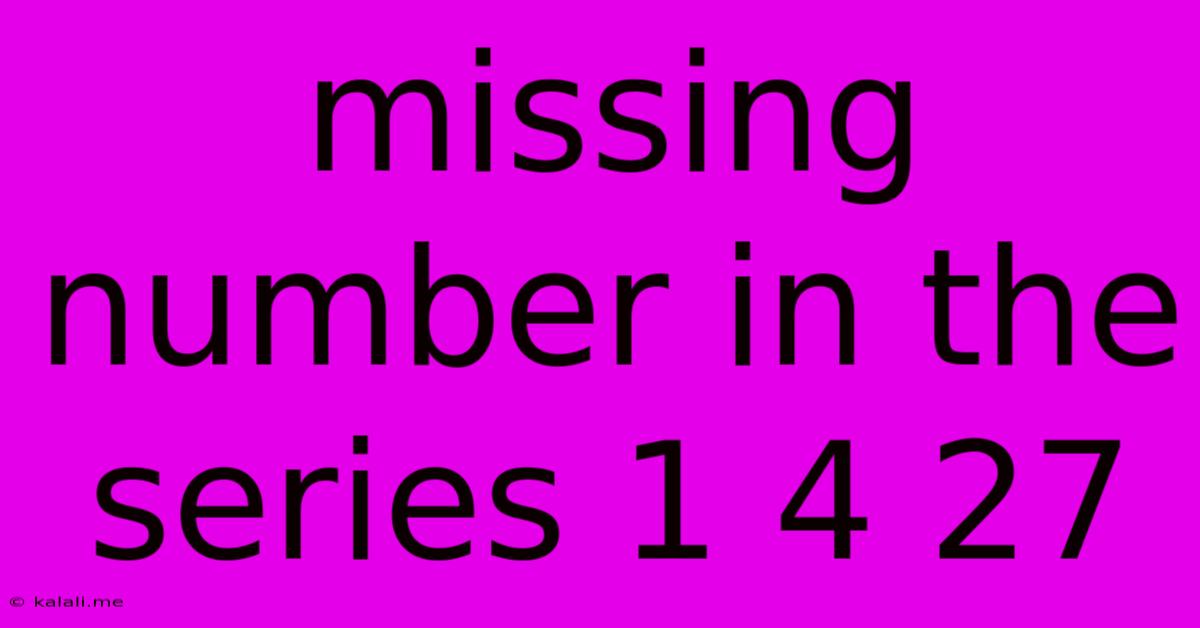Missing Number In The Series 1 4 27
Kalali
Jun 15, 2025 · 3 min read

Table of Contents
Unlocking the Mystery: The Missing Number in the Series 1, 4, 27
This article delves into the intriguing mathematical puzzle of the incomplete sequence: 1, 4, 27, __. Finding the missing number requires us to identify the underlying pattern or rule governing the sequence. At first glance, the pattern isn't immediately obvious, making this a challenging yet rewarding exercise in logical deduction and pattern recognition. Let's explore several potential solutions and the reasoning behind them.
Potential Patterns and Solutions
Several patterns could explain this sequence, each leading to a different missing number. The key is to identify a consistent rule that applies to all the existing numbers. Here are a few possibilities:
-
Cubing plus one: This pattern is a possible explanation that fits this series. If we examine the given numbers, we observe that:
- 1 = 1³ + 0
- 4 = 2³ - 4
- 27 = 3³
This pattern suggests a possible rule where we cube the position of the number in the sequence (n) and then add or subtract a value (let's call this 'x') to obtain the result. The formula could be expressed as: n³ + x. The challenge lies in determining the value of 'x' that consistently applies across the sequence. A consistent pattern remains elusive using this approach.
-
Raising to different powers: Another approach involves considering different powers. 1 is 1 to any power, 4 is 2 squared, and 27 is 3 cubed. This points towards raising each sequential number (n) to the power of 'n'. The formula then becomes n<sup>n</sup>. Applying this to the sequence:
- 1<sup>1</sup> = 1
- 2<sup>2</sup> = 4
- 3<sup>3</sup> = 27
Following this pattern, the next number in the sequence would be 4<sup>4</sup> = 256. This seems like a plausible solution for the missing number.
-
A combination of operations: More complex patterns involving a combination of operations (addition, subtraction, multiplication, division, etc.) could also be at play. However, without more data points, identifying such a pattern reliably is difficult. We might need additional numbers in the sequence to confirm or disprove this type of solution.
The Most Likely Answer and Why
While multiple patterns could be devised to fit the initial sequence, the simplest and most elegant solution is likely 256. The pattern of raising the number to the power of itself (n<sup>n</sup>) is a consistent and straightforward rule that explains the existing numbers and allows for the prediction of future numbers. The simplicity and elegance often indicate the correct answer in mathematical puzzles.
Conclusion: The Importance of Pattern Recognition
This exploration of the sequence 1, 4, 27 highlights the crucial role of pattern recognition in mathematics and problem-solving. Finding the missing number involves careful observation, logical deduction, and the consideration of various potential rules. The solution, while potentially multifaceted, often points towards the simplest and most consistent pattern. This exercise underscores the importance of looking beyond the immediate and exploring different mathematical concepts to unlock the hidden logic within number sequences.
Latest Posts
Latest Posts
-
Lowest Common Multiple Of 3 5 And 9
Jun 16, 2025
-
Center Of Mass Of A Trapezoid
Jun 16, 2025
-
Did Rabindranath Tagore Refused Nobel Prize
Jun 16, 2025
-
The Difference Between Inference And Observation
Jun 16, 2025
-
Amine Vs Amide Vs Imine Vs Imide
Jun 16, 2025
Related Post
Thank you for visiting our website which covers about Missing Number In The Series 1 4 27 . We hope the information provided has been useful to you. Feel free to contact us if you have any questions or need further assistance. See you next time and don't miss to bookmark.